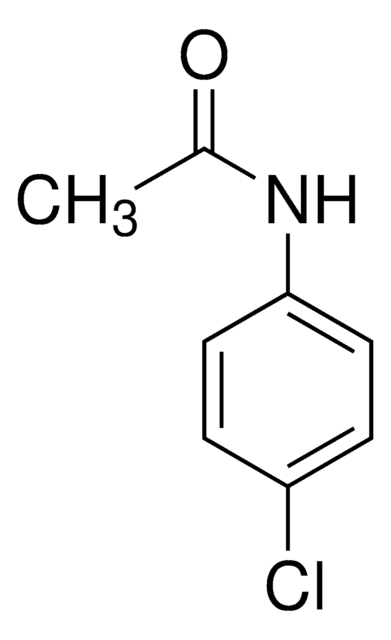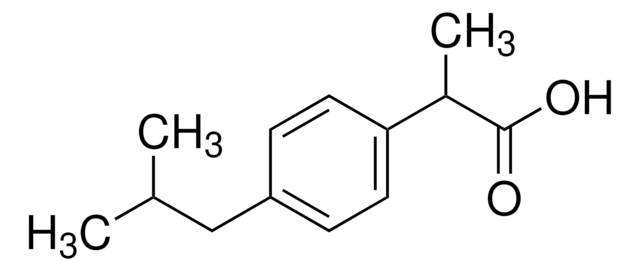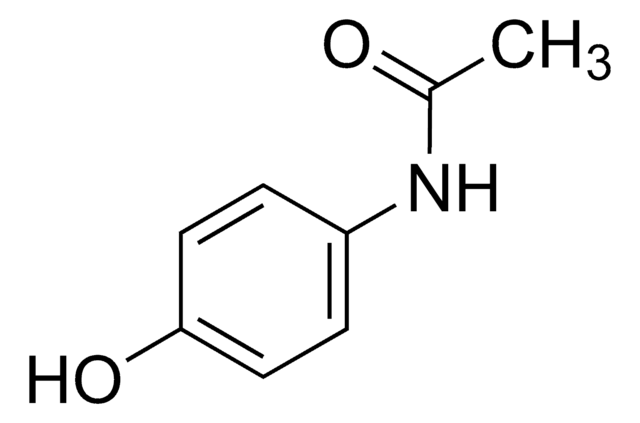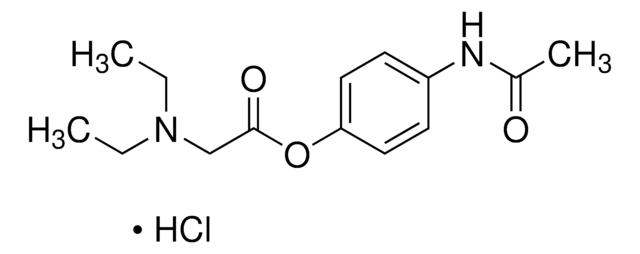P0300000
Acetaminofene
European Pharmacopoeia (EP) Reference Standard
Sinonimo/i:
4′-idrossiacetanilide, 4-acetamidofenolo, N-(4-idrossifenil)acetammide, N-acetil-4-amminofenolo, APAP, Paracetamolo
About This Item
Prodotti consigliati
Grado
pharmaceutical primary standard
Descrizione
API family: acetaminophen
Famiglia di API
paracetamol, acetaminophen
Produttore/marchio commerciale
EDQM
tecniche
HPLC: suitable
gas chromatography (GC): suitable
Punto di fusione
168-172 °C (lit.)
applicazioni
pharmaceutical (small molecule)
Formato
neat
Stringa SMILE
CC(=O)Nc1ccc(O)cc1
InChI
1S/C8H9NO2/c1-6(10)9-7-2-4-8(11)5-3-7/h2-5,11H,1H3,(H,9,10)
RZVAJINKPMORJF-UHFFFAOYSA-N
Informazioni sul gene
human ... FAAH(2166) , PTGS1(5742) , PTGS2(5743) , TRPV1(7442)
Cerchi prodotti simili? Visita Guida al confronto tra prodotti
Descrizione generale
Applicazioni
Confezionamento
Altre note
Prodotti correlati
Avvertenze
Warning
Indicazioni di pericolo
Consigli di prudenza
Classi di pericolo
Acute Tox. 4 Oral
Codice della classe di stoccaggio
11 - Combustible Solids
Classe di pericolosità dell'acqua (WGK)
WGK 1
Punto d’infiammabilità (°F)
364.3 °F - Pensky-Martens closed cup
Punto d’infiammabilità (°C)
184.6 °C - Pensky-Martens closed cup
Scegli una delle versioni più recenti:
Certificati d'analisi (COA)
Ci dispiace, ma al momento non ci sono COA disponibili online per questo prodotto.
Se ti serve aiuto, non esitare a contattarci Servizio Clienti
Possiedi già questo prodotto?
I documenti relativi ai prodotti acquistati recentemente sono disponibili nell’Archivio dei documenti.
I clienti hanno visto anche
Articoli
Separation of Acetaminophen, meets USP testing specifications, 98.0-102.0%, powder; Caffeine, meets USP testing specifications, anhydrous; Benzoic acid, meets USP testing specifications; Aspirin, meets USP testing specifications
Protocolli
Separation of Maleic acid; Acetaminophen; Caffeine; Naproxen; Ibuprofen
Il team dei nostri ricercatori vanta grande esperienza in tutte le aree della ricerca quali Life Science, scienza dei materiali, sintesi chimica, cromatografia, discipline analitiche, ecc..
Contatta l'Assistenza Tecnica.







